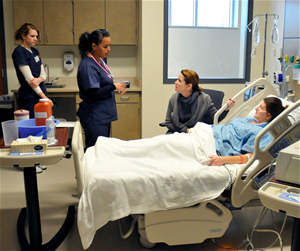 In nursing schools across the country, students learn how to intubate patients, take blood pressure, and check the pulse of their patients. What they don’t always experience until they are nurses is how it will be to work with doctors. And the same is true for medical students working with nurses. At Marian University, we’re changing that.
In nursing schools across the country, students learn how to intubate patients, take blood pressure, and check the pulse of their patients. What they don’t always experience until they are nurses is how it will be to work with doctors. And the same is true for medical students working with nurses. At Marian University, we’re changing that.
Each year, fourth-year nursing students and second-year medical students come together in the the Hill-Rom Simulation Center to learn how to work together like they will in the hospital upon graduation. This fall’s interprofessional activity simulated what doing rounds in a hospital would be like.
“It was a great experience to work with the nursing students during the simulation,” Michael Skaletsky, second-year medical student, said. “The discussion between providers, the understanding of what each other could do for the patient and then how we can address other patient concerns as a team was a perfect introduction to the physician-nurse-medical team relationship.”
Both housed and trained in the Michael A. Evans Center for Health Sciences, our medical and nursing students not only learn competencies, but also learn how to effectively work with one another.
“Our students need to continue these activities to continue to develop a ‘team’ mentality,” Linnea Nelson, DO, assistant professor of Family Medicine in Marian University College of Osteopathic Medicine, said. “They need to ask questions and ask for assistance, as well as give assistance. I instill in our students that they do not and never will have all of the answers. They are one part of the team.”
Nursing faculty see it as a great opportunity for their students as well.
“We felt this interprofessional experience was very beneficial for our students as they learn to become more comfortable in their interactions with healthcare providers,” Janet Hertzler, MSN, RN, assistant professor of nursing, said. “Our hope is to have more of these experiences with our medical students.”
Both medical and nursing faculty plan to offer many more opportunities for their students to learn with those outside of their profession and director of the university’s Hill-Rom Simulation Center, David Patterson, sees this as a growing trend in healthcare education.
“It is a curricular thread that is growing more pervasive,” Patterson said. “The more you can pull students out of the silo of individual experiences and drop them into experiences that are more like what they will do in the real world, the more likely it is that everyone benefits.”
